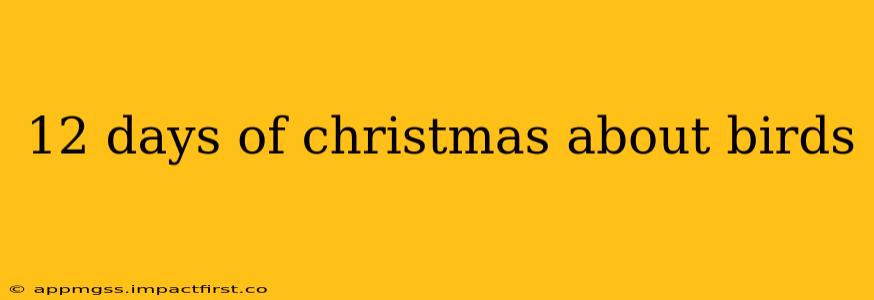The classic carol, "The Twelve Days of Christmas," is a gift-giving extravaganza. But what if we reimagined it, focusing on the avian world? Get ready for a feathered frenzy as we explore a bird-themed twist on this beloved holiday song! This isn't just a list; we'll dive into the fascinating behaviors and characteristics of each bird, making it a truly enriching and entertaining experience.
A Partridge in a Pear Tree
The traditional first gift sets the stage perfectly. A partridge, a ground-dwelling bird known for its shy nature and beautiful plumage, symbolizes the quiet beginnings of the holiday season. However, the "pear tree" element raises a few questions. Partridges don't typically associate with pear trees; the image is more symbolic of abundance and the natural world, a perfect backdrop for the festivities to unfold.
What kind of partridge is it?
This is often debated! The carol doesn't specify a particular species. Various partridges exist across the globe, each with unique characteristics. It's likely a reference to the common partridge found in the British Isles, familiar to carol writers of the time.
Two Turtle Doves
These gentle, cooing birds represent peace and love, perfectly fitting the spirit of Christmas. Turtle doves are known for their monogamous relationships, symbolizing lasting partnerships and the commitment shared during the holidays.
Why turtle doves specifically?
Their gentle cooing and association with courtship and pair-bonding likely made them a charming addition to the carol's imagery.
Three French Hens
Three French hens introduce a touch of continental flair to our bird-themed extravaganza. While not native to Britain, these hens are known for their elegant appearance and lively demeanor.
Where do French hens come from?
"French hen" likely refers to a type of domestic hen, possibly a breed originating in France, or simply indicating a stylish, refined bird. The exact breed remains ambiguous, contributing to the carol's enduring mystique.
Four Calling Birds
These birds are often debated. Some believe they are actually goldfinches or other similar small birds known for their beautiful songs. This interpretation lends itself well to the joyous sounds of the holiday season.
What birds are calling birds?
The identity of the "calling birds" remains a mystery, fueling speculation and debate amongst bird enthusiasts and carol fans alike.
Five Gold Rings (Golden Plovers)
Let's switch the rings for a beautiful, golden-hued bird! Golden Plovers, with their striking yellow-gold breast feathers, create a dazzling image for the fifth day. These birds are known for their long migrations, adding another layer of symbolic meaning.
Are golden plovers really golden?
While not literally gold, their striking plumage creates a captivating golden effect.
Six Geese a-Laying
Geese are known for their communal nature, and their association with plentiful egg-laying evokes imagery of abundance and the bounty of the harvest season. The image of six geese laying eggs enhances the theme of generous giving.
Why geese and not other birds?
Geese, with their size and ability to produce many eggs, add to the theme of abundance and prosperity associated with the Christmas season.
Seven Swans a-Swimming
These elegant birds, known for their graceful movements on water, bring a sense of serenity and beauty to the holiday celebrations. Swans are often associated with purity and loyalty, enhancing the themes of the season.
What kind of swans are they?
The carol doesn't specify the species, allowing for broad interpretation. The grace and beauty of swans in general contribute to the overall festive imagery.
Eight Maids a-Milking (Eight Milkmaids and their Ducks)
Let’s add a farmyard touch! Imagine eight milkmaids tending to their flocks of ducks. Ducks are known for their communal behavior and are often associated with rural landscapes, complementing the theme of milkmaids and the bucolic life.
Why ducks with milkmaids?
This adds a practical and charming element, reflecting the working lives of people during that era, and incorporating ducks common to farmyards.
Nine Ladies Dancing (Nine Dancing Birds of Paradise)
Let's move to the tropics! Nine Birds of Paradise, with their flamboyant plumage and elaborate courtship displays, add an exotic and vibrant flair to our bird-themed carol. Their dancing movements add a fun and energetic layer.
Birds of Paradise: Dancing?
Many species of Birds of Paradise engage in complex and fascinating courtship displays, often characterized as "dancing."
Ten Lords a-Leaping (Ten Leaping Kestrels)
These agile birds of prey, known for their impressive hunting skills and aerial acrobatics, add a sense of dynamism and excitement. Their leaping movements represent energy and thrill.
Why kestrels?
Kestrels exhibit fascinating hunting behaviors, with their distinctive hovering and sudden leaps to catch prey. This adds a thrilling element to the day.
Eleven Pipers Piping (Eleven Mockingbirds)
Mockingbirds, renowned for their exceptional vocalizations and ability to mimic various sounds, provide a melodious backdrop to the holiday celebrations. Their piping adds a musical dimension to the day.
Why mockingbirds?
Their incredible vocalizations and mimicking abilities fit perfectly with the theme of music and festive sounds.
Twelve Drummers Drumming (Twelve Woodpeckers Drumming)
We finish with a percussive finale! Woodpeckers, with their distinctive drumming on tree trunks, create a rhythmic and lively conclusion. Their drumming provides a unique and natural percussion.
Woodpeckers: Natural drummers?
Woodpeckers use their beaks to drum on trees, both for communication and to find food, creating a naturally rhythmic sound.
This bird-themed version of "The Twelve Days of Christmas" transforms a beloved carol into a vibrant celebration of avian life, highlighting the beauty, diversity, and fascinating behaviors of birds from around the world. It's a fun and educational way to appreciate both the carol and the natural world!
